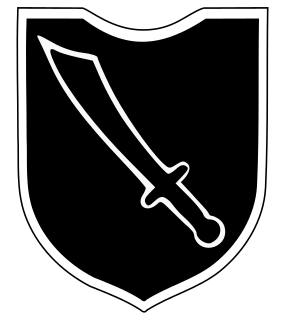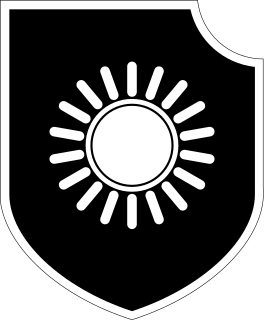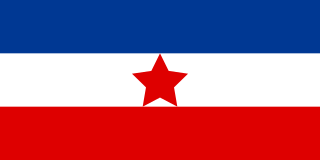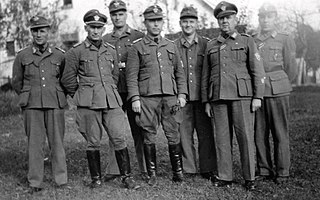 W
WAfter the Kingdom of Yugoslavia was invaded by the Axis powers during World War II, all of Bosnia was ceded to the newly created Independent State of Croatia. Axis rule in Bosnia led to widespread persecution and mass-killings of native undesirables and anti-fascists. Many Serbs themselves took up arms and joined the Chetniks, a Serb nationalist and royalist resistance movement that conducted ineffective guerrilla warfare against the occupying Nazi forces. On 12 October 1941 a group of 108 notable Muslim citizens of Sarajevo signed the Resolution of Sarajevo Muslims by which they condemned the persecution of Serbs organized by Ustaše, made distinction between Muslims who participated in such persecutions and whole Muslim population, presented information about the persecutions of Muslims by Serbs and requested security for all citizens of the country, regardless of their identity.Bosnia was the geographical mother of the partisan movement, providing ample space amongst its mountains for training and development.
 W
WThe 13th Waffen Mountain Division of the SS Handschar was a mountain infantry division of the Waffen-SS, an armed branch of the German Nazi Party that served alongside but was never formally part of the Wehrmacht during World War II. At the post-war Nuremberg trials, the Waffen-SS was declared to be a criminal organisation due to its major involvement in war crimes and crimes against humanity. From March to December 1944, the division fought a counter-insurgency campaign against communist-led Yugoslav Partisan resistance forces in the Independent State of Croatia, a fascist puppet state of Germany that encompassed almost all of modern-day Croatia, all of modern-day Bosnia and Herzegovina as well as parts of Serbia. It was given the title Handschar after a local fighting knife or sword carried by Ottoman policemen during the centuries that the region was part of the Ottoman Empire. It was the first non-Germanic Waffen-SS division, and its formation marked the expansion of the Waffen-SS into a multi-ethnic military force. Composed of Bosnian Muslims with some Catholic Croat soldiers and mostly German and Yugoslav Volksdeutsche officers and non-commissioned officers, it took an oath of allegiance to both Adolf Hitler and the Croatian leader Ante Pavelić.
 W
WThe 23rd Waffen Mountain Division of the SS Kama was a German mountain infantry division of the Waffen-SS, the armed wing of the German Nazi Party that served alongside but was never formally part of the Wehrmacht during World War II. At the post-war Nuremberg trials, the Waffen-SS was declared to be a criminal organisation due to its major involvement in war crimes and crimes against humanity. The division was composed of German officers and Bosnian Muslim soldiers. Named Kama after a small dagger used by Balkan shepherds, it was one of the thirty-eight divisions fielded by the Waffen-SS during World War II. Formed on 19 June 1944, it was built around a cadre from the 13th Waffen Mountain Division of the SS Handschar but did not reach its full strength and never saw action as a formation.
 W
WThe 24th Waffen Mountain Division of the SS "Karstjäger" was a German mountain infantry division of the Waffen-SS, the armed wing of the German Nazi Party that served alongside, but was never formally part of, the Wehrmacht during World War II. At the post-war Nuremberg trials, the Waffen-SS was declared to be a criminal organisation due to its major involvement in war crimes and crimes against humanity. Named Karstjäger, the formation was one of the 38 divisions fielded by the Waffen-SS. Formed on 18 July 1944 from the SS Volunteer Karstwehr Battalion, its nominal strength was never more than theoretical and the division was soon reduced to the Waffen Mountain (Karstjäger) Brigade of the SS. Throughout its existence as a battalion, division and brigade, it was primarily involved in fighting partisans in the Karst Plateau on the frontiers of Yugoslavia, Italy, and Austria; the mountainous terrain required specialised mountain troops and equipment.
 W
WThe Bihać Republic was a short-lived republic that existed between November 1942 and January 1943 in a liberated area of Nazi-occupied Yugoslavia. It was established by the Partisan resistance movement following the liberation of Bihać. Bihać became its administrative center and the first session of the Anti-Fascist Council of the People's Liberation of Yugoslavia (AVNOJ) was held there on 26 November 1942.
 W
WThe Chetniks, formally the Chetnik Detachments of the Yugoslav Army, and also the Yugoslav Army in the Homeland and the Ravna Gora Movement, was a Yugoslav royalist and Serbian nationalist movement and guerrilla force in Axis-occupied Yugoslavia. Although it was not a homogeneous movement, it was led by Draža Mihailović. While it was anti-Axis in its long-term goals and engaged in marginal resistance activities for limited periods, it also engaged in tactical or selective collaboration with the occupying forces for almost all of the war. The Chetnik movement adopted a policy of collaboration with regard to the Axis, and engaged in cooperation to one degree or another by establishing modus vivendi or operating as "legalised" auxiliary forces under Axis control. Over a period of time, and in different parts of the country, the movement was progressively drawn into collaboration agreements: first with the puppet Government of National Salvation in the German-occupied territory of Serbia, then with the Italians in occupied Dalmatia and Montenegro, with some of the Ustaše forces in northern Bosnia, and, after the Italian capitulation in September 1943, with the Germans directly.
 W
WThe Independent State of Croatia was a World War II-era puppet state of Nazi Germany and Fascist Italy. It was established in parts of occupied Yugoslavia on 10 April 1941, after the invasion by the Axis powers. Its territory consisted of most of modern-day Croatia and Bosnia and Herzegovina, as well as some parts of modern-day Serbia and Slovenia, but also excluded many Croat-populated areas in Dalmatia, Istria, and Međimurje regions.
 W
WThe Dinara Division was an irregular Chetnik formation that existed during the World War II Axis occupation of Yugoslavia that largely operated as auxiliaries of the occupying forces and fought the Yugoslav Partisans. Organized in 1942 with assistance from Ilija Trifunović-Birčanin and headed by Momčilo Đujić, the division incorporated commanders in Bosnia and Herzegovina, northern Dalmatia, and the Lika region. The division was under the control of supreme Chetnik commander Draža Mihailović and received aid from Dimitrije Ljotić, leader of the Serbian Volunteer Corps, and Milan Nedić, head of the Serbian puppet Government of National Salvation.
 W
WThe Eternal flame is a memorial to the military and civilian victims of the Second World War in Sarajevo, Bosnia and Herzegovina. The memorial was dedicated on 6 April 1946, the first anniversary of the liberation of Sarajevo from the four-year-long occupation by Nazi Germany and the fascist Independent State of Croatia.
 W
WThe Genocide of the Serbs was the systematic persecution of Serbs which was committed during World War II by the fascist Ustaše regime in the Nazi German puppet state known as the Independent State of Croatia between 1941 and 1945. It was carried out through executions in death camps, as well as through mass murder, ethnic cleansing, deportations, forced conversions, and war rape. This genocide was simultaneously carried out with the Holocaust in the NDH as well as the genocide of Roma, by combining Nazi racial policies with the ultimate goal of creating an ethnically pure Greater Croatia.
 W
WThe German-Croatian Police, also known as the German-Croatian SS Police and Gendarmerie, was a force established by the SS for internal security operations in the Independent State of Croatia, a puppet state of Nazi Germany during World War II. In all, 32,000 Croats served in the various units of this Police force, under German command, with the task of preserving order and help defend Axis strategic positions throughout the country.
 W
WGreen cadres (paramilitary) was a Bosniak nationalist paramilitary force during World War II. They were founded in early December 1941 as a reaction to a massacre on Bosniak men and women carried out in Foča by the Serb Chetniks. The organisation was formed in poor conditions and was not so supported at first by the Croatian puppet government. They rose to power after the Partisans started to burst deeper into Bosnia. Their leader was Nešad Topčić.
 W
WThe Holocaust in the Independent State of Croatia is a term which is primarily used in reference to the genocide of Jews, but sometimes, it is also used in reference to the genocide of Serbs and Romani (Porajmos), within the Independent State of Croatia, a fascist puppet state which existed during World War II, was led by the Ustaše regime, and ruled an occupied area of Yugoslavia which included most of the territory of modern-day Croatia, the whole of modern-day Bosnia and Herzegovina and the eastern part of Syrmia (Serbia). Of the 39,000 Jews who lived in the NDH in 1941, the United States Holocaust Memorial Museum states that more than 30,000 were killed. Of these, 6,200 were shipped to Nazi Germany and the rest of them were killed in the ISC, the vast majority were killed in Ustaše-run concentration camps, such as Jasenovac. The Ustaše were the only quisling forces in Europe who operated their own extermination camps for the purpose of killing Jews and members of other ethnic groups.
 W
WThe Battle of Odžak was the last battle of World War II in Europe. The battle began on 19 April 1945 and lasted until 25 May 1945, 17 days after the end of the war in Europe. The combatants were Ustashe commanded by Petar Rajkovačić and the Yugoslav Partisans commanded by Miloš Zekić. The battle took place in the Bosnian town of Odžak. The battle was a victory for the Partisans.
 W
WOperation Alfa was an offensive carried out in early October 1942 by Italian, Croatian and Chetnik forces against the communist-led Partisans in the Prozor region, then a part of the Croatian puppet state, the Independent State of Croatia (NDH). The operation was militarily inconclusive, and in the aftermath, Chetnik forces conducted mass killings of civilians in the area.
 W
WOperation Halyard, known in Serbian as Operation Air Bridge, was an Allied airlift operation behind Axis lines during World War II. In July 1944, the Office of Strategic Services (OSS) drew up plans to send a team to the Chetniks force led by General Draža Mihailović in the German-occupied Territory of the Military Commander in Serbia for the purpose of evacuating Allied airmen shot down over that area. This team, known as the Halyard team, was commanded by Lieutenant George Musulin, along with Master Sergeant Michael Rajacich, and Specialist Arthur Jibilian, the radio operator. The team was detailed to the United States Fifteenth Air Force and designated as the 1st Air Crew Rescue Unit. It was the largest rescue operation of American Airmen in history. According to historian Professor Jozo Tomasevich, a report submitted to the OSS showed that 417 Allied airmen who had been downed over occupied Yugoslavia were rescued by Mihailović's Chetniks, and airlifted out by the Fifteenth Air Force. According to Lt. Cmdr. Richard M. Kelly (OSS) grand total of 432 U.S. and 80 Allied personnel were airlifted during the Halyard Mission.
 W
WThe Women's Antifascist Front of Bosnia and Herzegovina, usually abbreviated to AFŽ BiH, was a mass organization in the People's Republic of Bosnia and Herzegovina. It was established by the Communist Party in February 1942, over a year before the republic itself, with the aim of mobilizing women in Bosnia and Herzegovina into the Partisan resistance against the Nazi occupation of Yugoslavia. It was one of the organizations which gave rise to the Women's Antifascist Front of Yugoslavia, the first congress of which was held in December 1942 in Bosanski Petrovac.